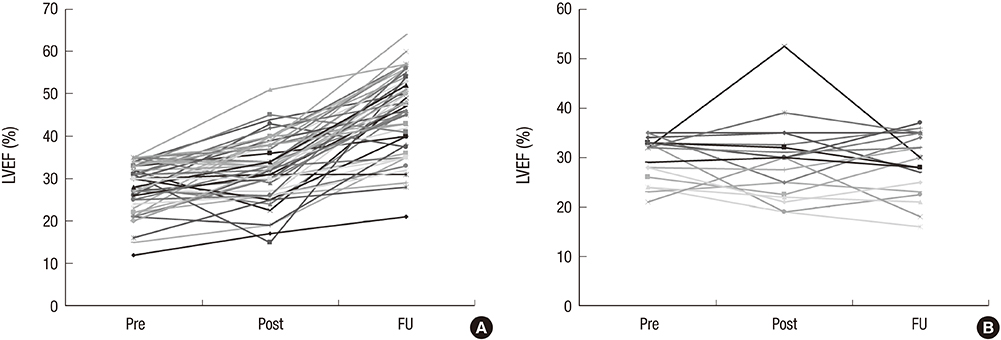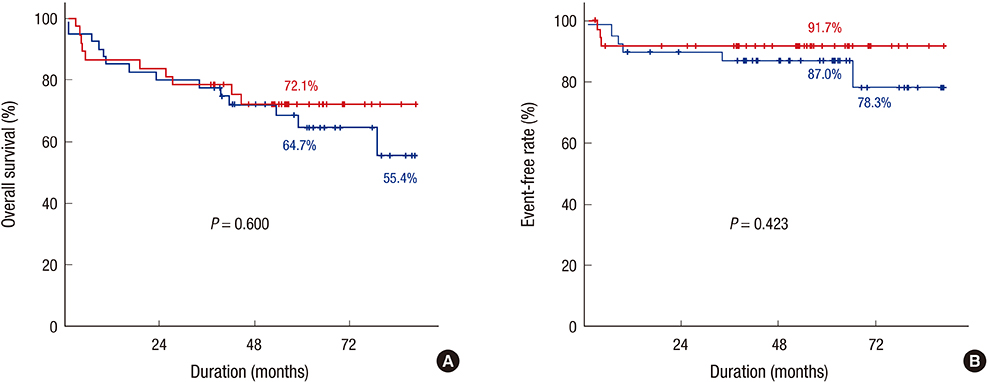J Korean Med Sci.
2017 Dec;32(12):2009-2015. 10.3346/jkms.2017.32.12.2009.
Cardiac Magnetic Resonance Predictor of Ventricular Function after Surgical Coronary Revascularization
- Affiliations
-
- 1Department of Thoracic and Cardiovascular Surgery, Seoul National University Hospital, Seoul, Korea. kimkb@snu.ac.kr
- 2Department of Thoracic and Cardiovascular Surgery, Seoul Metropolitan Government-Seoul National University Boramae Medical Center, Seoul, Korea.
- 3Department of Radiology, Seoul National University Hospital, Seoul, Korea.
- KMID: 2396379
- DOI: http://doi.org/10.3346/jkms.2017.32.12.2009
Abstract
- We evaluated echocardiographic changes of left ventricular (LV) function in coronary artery bypass grafting (CABG) patients with LV dysfunction, and examined cardiac magnetic resonance (CMR) parameters associated with improved LV function. Seventy-seven CABG patients presenting with decreased LV ejection fraction (LVEF, ≤ 35%) and who underwent preoperative gadolinium-enhanced CMR were enrolled. A 16-segment model was used to analyze CMR imaging. A viable myocardial segment was defined as ≤ 50% transmural extent of late gadolinium enhancement. Serial echocardiographic examinations were performed preoperatively, pre-discharge (median 6 days), and during postoperative year 1 (median 11 months) in 70 patients. Predictors of absolute increase in LVEF (≥ 5%) and proportional changes in LVEF were analyzed. Serial echocardiography demonstrated that LVEF measured 28.6% ± 5.4% preoperatively, 31.5% ± 8.0% median 6 days, and 42.1% ± 10.5% median 11 months postoperatively. Absolute increase of LVEF was observed in 27 patients at pre-discharge and in 24 patients by median 11 months. Proportional changes in LVEF at postoperative median 6 days and 11 months were 14% ± 28% and 57% ± 45%, respectively. The median number of viable myocardial segments was 14 (range, 9-16) in the 16 segment CMR model. Multivariable models demonstrated that the median number of overall viable myocardial segments (≥ 14) in preoperative CMR was associated with absolute increase (P = 0.046) and proportional changes (P = 0.005) in LVEF. In conclusion, the number of viable myocardial segments (≥ 14) in preoperative CMR predicted LV function improvement after CABG in patients with LV dysfunction.
Keyword
MeSH Terms
Figure
Cited by 2 articles
-
Ideal Suggestions for Discharge Training and Telephone Counseling of Patients With Coronary Artery Bypass Graft Surgery: A Randomized Controlled and Experimental Study
Ufuk Kaya, Ümran Dal Yılmaz
J Korean Med Sci. 2022;37(35):e269. doi: 10.3346/jkms.2022.37.e269.Impact of Positron Emission Tomography Viability Imaging: Guided Revascularizations on Clinical Outcomes in Patients With Myocardial Scar on Single-Photon Emission Computed Tomography Scans
Jong Sung Park, Jang Hoon Lee, Chae Moon Hong, Bo Eun Park, Yoon Jung Park, Hong Nyun Kim, Namkyun Kim, Se Yong Jang, Myung Hwan Bae, Dong Heon Yang, Hun Sik Park, Yongkeun Cho
J Korean Med Sci. 2023;38(46):e399. doi: 10.3346/jkms.2023.38.e399.
Reference
-
1. Alderman EL, Fisher LD, Litwin P, Kaiser GC, Myers WO, Maynard C, Levine F, Schloss M. Results of coronary artery surgery in patients with poor left ventricular function (CASS). Circulation. 1983; 68:785–795.2. Pigott JD, Kouchoukos NT, Oberman A, Cutter GR. Late results of surgical and medical therapy for patients with coronary artery disease and depressed left ventricular function. J Am Coll Cardiol. 1985; 5:1036–1045.3. Bax JJ, Poldermans D, Elhendy A, Cornel JH, Boersma E, Rambaldi R, Roelandt JR, Fioretti PM. Improvement of left ventricular ejection fraction, heart failure symptoms and prognosis after revascularization in patients with chronic coronary artery disease and viable myocardium detected by dobutamine stress echocardiography. J Am Coll Cardiol. 1999; 34:163–169.4. Baer FM, Theissen P, Crnac J, Schmidt M, Deutsch HJ, Sechtem U, Schicha H, Erdmann E. Head to head comparison of dobutamine-transoesophageal echocardiography and dobutamine-magnetic resonance imaging for the prediction of left ventricular functional recovery in patients with chronic coronary artery disease. Eur Heart J. 2000; 21:981–991.5. Samady H, Elefteriades JA, Abbott BG, Mattera JA, McPherson CA, Wackers FJ. Failure to improve left ventricular function after coronary revascularization for ischemic cardiomyopathy is not associated with worse outcome. Circulation. 1999; 100:1298–1304.6. Klein C, Nekolla SG, Bengel FM, Momose M, Sammer A, Haas F, Schnackenburg B, Delius W, Mudra H, Wolfram D, et al. Assessment of myocardial viability with contrast-enhanced magnetic resonance imaging: comparison with positron emission tomography. Circulation. 2002; 105:162–167.7. Wu YW, Tadamura E, Kanao S, Yamamuro M, Marui A, Komeda M, Toma M, Kimura T, Togashi K. Myocardial viability by contrast-enhanced cardiovascular magnetic resonance in patients with coronary artery disease: comparison with gated single-photon emission tomography and FDG position emission tomography. Int J Cardiovasc Imaging. 2007; 23:757–765.8. Kim RJ, Wu E, Rafael A, Chen EL, Parker MA, Simonetti O, Klocke FJ, Bonow RO, Judd RM. The use of contrast-enhanced magnetic resonance imaging to identify reversible myocardial dysfunction. N Engl J Med. 2000; 343:1445–1453.9. Schvartzman PR, Srichai MB, Grimm RA, Obuchowski NA, Hammer DF, McCarthy PM, Kasper JM, White RD. Nonstress delayed-enhancement magnetic resonance imaging of the myocardium predicts improvement of function after revascularization for chronic ischemic heart disease with left ventricular dysfunction. Am Heart J. 2003; 146:535–541.10. Hwang HY, Lee KH, Han JW, Kim KB. Equivalency of saphenous vein and arterial composite grafts: 5-year angiography and midterm clinical follow-up. Ann Thorac Surg. 2016; 102:580–588.11. Oh SJ, Park EA, Lee W, Hwang HY, Kim KB. Improved wall motion of late gadolinium-enhanced myocardium after complete surgical revascularization. Ann Thorac Surg. 2015; 99:1554–1560.12. Cerqueira MD, Weissman NJ, Dilsizian V, Jacobs AK, Kaul S, Laskey WK, Pennell DJ, Rumberger JA, Ryan T, Verani MS, et al. Standardized myocardial segmentation and nomenclature for tomographic imaging of the heart. A statement for healthcare professionals from the Cardiac Imaging Committee of the Council on Clinical Cardiology of the American Heart Association. Circulation. 2002; 105:539–542.13. Hendel RC, Budoff MJ, Cardella JF, Chambers CE, Dent JM, Fitzgerald DM, Hodgson JM, Klodas E, Kramer CM, Stillman AE, et al. ACC/AHA/ACR/ASE/ASNC/HRS/NASCI/RSNA/SAIP/SCAI/SCCT/SCMR/SIR 2008 key data elements and definitions for cardiac imaging: a report of the American College of Cardiology/American Heart Association Task Force on clinical data standards (Writing Committee to Develop Clinical Data Standards for Cardiac Imaging). Circulation. 2009; 119:154–186.14. Vanoverschelde JL, Depré C, Gerber BL, Borgers M, Wijns W, Robert A, Dion R, Melin JA. Time course of functional recovery after coronary artery bypass graft surgery in patients with chronic left ventricular ischemic dysfunction. Am J Cardiol. 2000; 85:1432–1439.15. Mazumdar M, Glassman JR. Categorizing a prognostic variable: review of methods, code for easy implementation and applications to decision-making about cancer treatments. Stat Med. 2000; 19:113–132.16. Chae IH, Yoon CH, Park JJ, Oh IY, Suh JW, Cho YS, Youn TJ, Choi DJ. Comparison of drug-eluting balloon followed by bare metal stent with drug-eluting stent for treatment of de novo lesions: randomized, controlled, single-center clinical trial. J Korean Med Sci. 2017; 32:933–941.17. Paeng JC, Lee DS, Kang WJ, Lee BI, Kim KB, Chung JK, Lee MC. Time course of functional recovery after coronary artery bypass grafting surgery according to the preoperative reversibility of perfusion impairment on myocardial SPECT. Eur J Nucl Med Mol Imaging. 2005; 32:70–74.18. Cho KR, Hwang HY, Kang WJ, Lee DS, Kim KB. Progressive improvement of myocardial perfusion after off-pump revascularization with bilateral internal thoracic arteries: comparison of early versus 1-year postoperative myocardial single photon emission computed tomography. J Thorac Cardiovasc Surg. 2007; 133:52–57.19. Beek AM, Kühl HP, Bondarenko O, Twisk JW, Hofman MB, van Dockum WG, Visser CA, van Rossum AC. Delayed contrast-enhanced magnetic resonance imaging for the prediction of regional functional improvement after acute myocardial infarction. J Am Coll Cardiol. 2003; 42:895–901.20. Selvanayagam JB, Kardos A, Francis JM, Wiesmann F, Petersen SE, Taggart DP, Neubauer S. Value of delayed-enhancement cardiovascular magnetic resonance imaging in predicting myocardial viability after surgical revascularization. Circulation. 2004; 110:1535–1541.21. Choi KM, Kim RJ, Gubernikoff G, Vargas JD, Parker M, Judd RM. Transmural extent of acute myocardial infarction predicts long-term improvement in contractile function. Circulation. 2001; 104:1101–1107.22. Yang T, Lu MJ, Sun HS, Tang Y, Pan SW, Zhao SH. Myocardial scar identified by magnetic resonance imaging can predict left ventricular functional improvement after coronary artery bypass grafting. PLoS One. 2013; 8:e81991.23. Pegg TJ, Selvanayagam JB, Jennifer J, Francis JM, Karamitsos TD, Dall’Armellina E, Smith KL, Taggart DP, Neubauer S. Prediction of global left ventricular functional recovery in patients with heart failure undergoing surgical revascularisation, based on late gadolinium enhancement cardiovascular magnetic resonance. J Cardiovasc Magn Reson. 2010; 12:56.
- Full Text Links
- Actions
-
Cited
- CITED
-
- Close
- Share
- Similar articles
-
- Cardiac MRI
- Comparison of Left and Right Ventricular Volume and Cardiac Output by MRI and Echocardiography
- Assessment of Right Ventricular Structure and Function in Pulmonary Hypertension
- Myocardial Contractility, Perfusion, and Viability Analysis Using Multidetector CT in Patients with Ischemic Heart Disease
- Cardiac MR Assessment of Coronary Arteries




